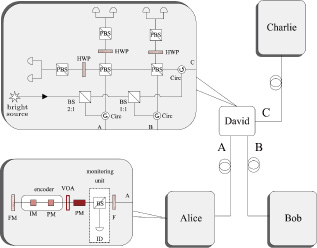Measurement-device-independent quantum cryptographic conferencing with an untrusted source
(color online) Schematic layout of the MDI-QCC with an untrusted source setup. An untrusted relay, David, generates bright laser pulses. They are split into three parts by two beam splitters (BS). Before entering Alice’s, Bob’s, and Charlie’s lab, the pulses will travel through the channel, which is fully controlled by Eve. In the lab, to ensure the single mode assumption for each signal, the pulses pass through an optical filter (F) first. After that, a monitoring unit, which consists of a BS and an intensity detector (ID), is needed to monitor the photon number distribution of the input pulse. Then, the input pulses pass through a phase modulator (PM) for phase randomization, a variable optical attenuator (VOA) and an encoder that consists of an intensity modulator (IM) and a PM. Finally, the pulses are reflected by a Faraday mirror (FM) and travel back to David who is supposed to perform a GHZ-state measurement. [
